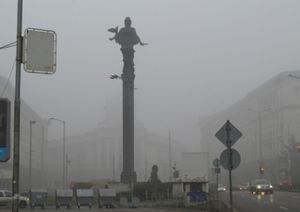Difference between revisions of "ISSS608 2018-19 T1 Assign Zhang Kexin"
Kxzhang.2017 (talk | contribs) |
Kxzhang.2017 (talk | contribs) |
||
| Line 26: | Line 26: | ||
<br/> | <br/> | ||
== Overview == | == Overview == | ||
| + | |||
| + | Air pollution is an important risk factor for health in Europe and worldwide. A recent review of the global burden of disease showed that it is one of the top ten risk factors for health globally. Worldwide an estimated 7 million people died prematurely because of pollution; in the European Union (EU) 400,000 people suffer a premature death. The Organisation for Economic Cooperation and Development (OECD) predicts that in 2050 outdoor air pollution will be the top cause of environmentally related deaths worldwide. In addition, air pollution has also been classified as a leading environmental cause of cancer. | ||
| + | |||
| + | Air quality in Bulgaria is a big concern: measurements show that citizens all over the country breathe in air that is considered harmful to health. For example, concentrations of PM2.5 and PM10 are much higher than what the EU and the World Health Organization (WHO) have set to protect health. Bulgaria had the highest PM2.5 concentrations of all EU-28 member states in urban areas over a three-year average. For PM10, Bulgaria is also leading on the top polluted countries with 77 μg/m3 on the daily mean concentration (EU limit value is 50 μg/m3). According to the WHO, 60 percent of the urban population in Bulgaria is exposed to dangerous (unhealthy) levels of particulate matter (PM10). | ||
| + | |||
| + | Sofia is the capital and largest city of Bulgaria. The air quality in Sofia is catastrophic. In virtually all parts of the city, the Particulate Matter (PM) concentration exceeded acceptable levels by far. In the very center of Sofia, the PM10 concentration was up to 466µg/m³, while nobody should be breathing air with more than 50µg/m³. | ||
| + | |||
| + | In this visualization analysis of Sofia air quality, I am going to do the spatio-temporal analysis of air quality based on 4 datasets including official air quality measurements, citizen science air quality measurements, meteorological measurements, and topography data. Also, there are many factors affecting urban air quality, such as local energy sources, local meteorology, local topography, and transboundary pollution. I am going to reveal the relationships between these factors mentioned above and the air quality measurements in Sofia. | ||
== Data Overview == | == Data Overview == | ||
Revision as of 12:21, 17 November 2018
|
|
|
|
|
Contents
Overview
Air pollution is an important risk factor for health in Europe and worldwide. A recent review of the global burden of disease showed that it is one of the top ten risk factors for health globally. Worldwide an estimated 7 million people died prematurely because of pollution; in the European Union (EU) 400,000 people suffer a premature death. The Organisation for Economic Cooperation and Development (OECD) predicts that in 2050 outdoor air pollution will be the top cause of environmentally related deaths worldwide. In addition, air pollution has also been classified as a leading environmental cause of cancer.
Air quality in Bulgaria is a big concern: measurements show that citizens all over the country breathe in air that is considered harmful to health. For example, concentrations of PM2.5 and PM10 are much higher than what the EU and the World Health Organization (WHO) have set to protect health. Bulgaria had the highest PM2.5 concentrations of all EU-28 member states in urban areas over a three-year average. For PM10, Bulgaria is also leading on the top polluted countries with 77 μg/m3 on the daily mean concentration (EU limit value is 50 μg/m3). According to the WHO, 60 percent of the urban population in Bulgaria is exposed to dangerous (unhealthy) levels of particulate matter (PM10).
Sofia is the capital and largest city of Bulgaria. The air quality in Sofia is catastrophic. In virtually all parts of the city, the Particulate Matter (PM) concentration exceeded acceptable levels by far. In the very center of Sofia, the PM10 concentration was up to 466µg/m³, while nobody should be breathing air with more than 50µg/m³.
In this visualization analysis of Sofia air quality, I am going to do the spatio-temporal analysis of air quality based on 4 datasets including official air quality measurements, citizen science air quality measurements, meteorological measurements, and topography data. Also, there are many factors affecting urban air quality, such as local energy sources, local meteorology, local topography, and transboundary pollution. I am going to reveal the relationships between these factors mentioned above and the air quality measurements in Sofia.
Data Overview
Data Preparation
Task Insights
Task 1: Spatio-temporal Analysis of Official Air Quality
- Characterize the past and most recent situation with respect to air quality measures in Sofia City
- What does a typical day look like for Sofia city?
- Do you see any trends of possible interest in this investigation?
- What anomalies do you find in the official air quality dataset?
- How do these affect your analysis of potential problems to the environment?
